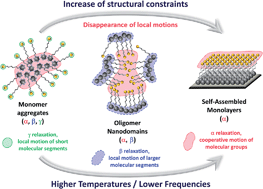From monomers to self-assembled monolayers: the evolution of molecular mobility with structural confinements†
Abstract
The effect of structural constriction on molecular mobility is investigated by broadband dielectric spectroscopy (BDS) within three types of molecular arrangements: monomers, oligomers and self-assembled monolayers (SAMs). While disordered monomers exhibit a variety of cooperative and local relaxation processes, the constrained nanodomains of oligomers and highly ordered structure of monolayers exhibit much hindered local molecular fluctuations. Particularly, in SAMs, motions of the silane headgroups are totally prevented whereas the polar endgroups forming the monolayer canopy show only one cooperative relaxation process. This latter molecular fluctuation is, for the first time, observed independently from other overlapping dielectric signals. Numerous electrostatic interactions among those dipolar endgroups are responsible for the strong cooperativity and heterogeneity of the canopy relaxation process. Our data analyses also revealed that the bulkiness of dipolar endgroups can disrupt the organization of the monolayer canopy thus increasing their ability to fluctuate as temperature is increased.



 Please wait while we load your content...
Please wait while we load your content...